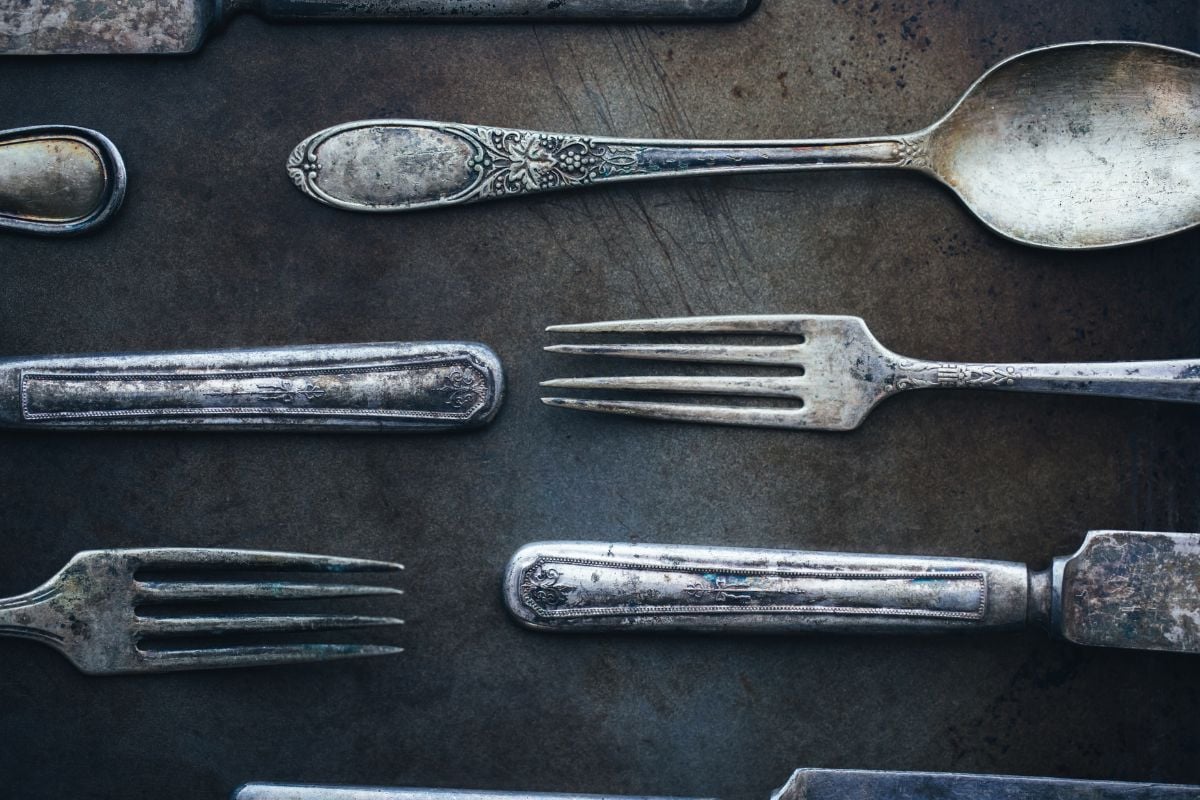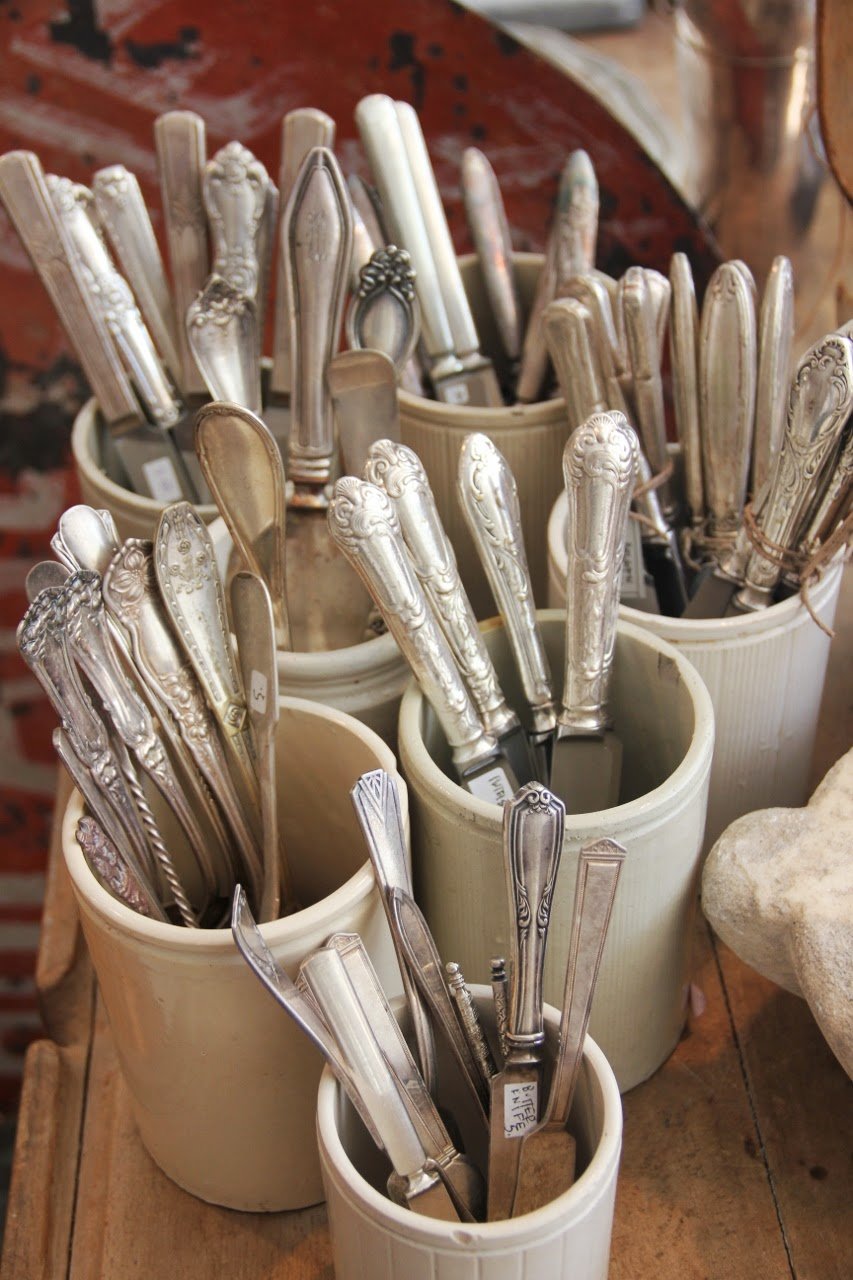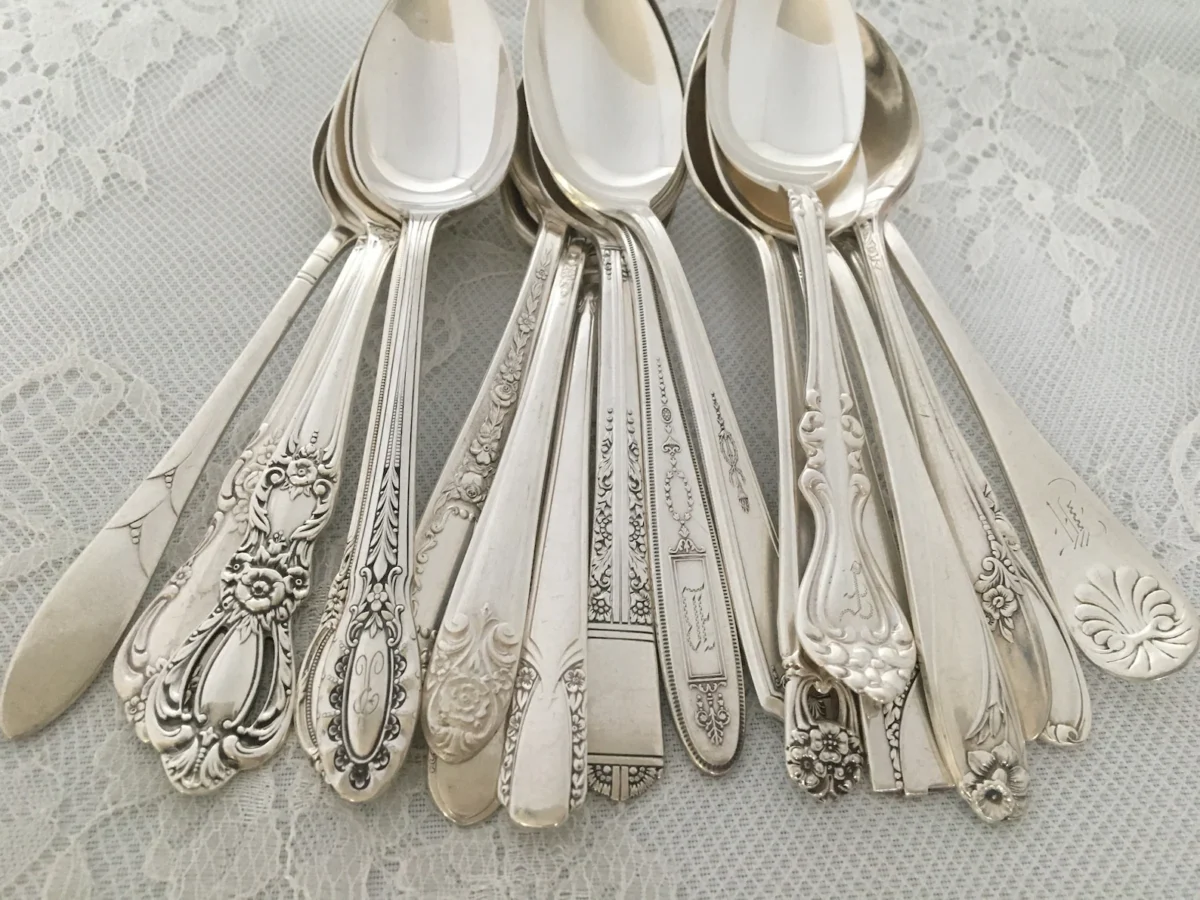Don’t let beautiful old silverware languish in a box or drawer ~ dig it out, buff it up, and let’s use it!

Once you’ve hit a certain age you probably have a stash of old silverware stowed away somewhere in your house. Maybe you inherited it, or received it as a wedding gift. It might be in a drawer in your dining room, it might be in a box in the garage, or in a plastic baggie in the attic. Most likely you only think about it for two days a year, during the holidays. But whether it’s from a great grandmother, or just the thrift store, it’s really too beautiful to hide away.
I’ll show you how to use and care for that vintage silverware ~ let’s unpack it together!

is it silver, or silver plate?
First off you need to know what you’ve got. Is your tableware sterling silver, or plated? Sometimes the answer is obvious: silver plated pieces can look mottled or have flaking in areas that reveal the base metal underneath. But in other cases it can be difficult to tell the difference. Here are the top ways experts distinguish between silver and silver plate:
- Check for a stamp or hallmark: all commercially sold silver will be marked with the name of the manufacturer, and the purity of the metal. Silver has a 92.5% or higher purity rating. If your piece is marked A1, that indicates silver plate.
- Use a magnet ~ real silver is not magnetic. If your magnet sticks, your piece is not silver.
- The white cloth test: silver is constantly oxidizing. Rub a soft white cloth over the piece, if you see any black marks on the cloth, that indicates real silver.

how to safely store silverware
Here are some pro tips on how to store your silverware. But above all, you should store it where you can get at it on a regular basis! If it’s out of sight it will be out of mind, and that’s a waste.
I inherited a set of silverware from my mother in law and I keep it in my dining room sideboard drawer wrapped in the original silver cloth. Silver cloth is a soft flannel fabric that has been infused with microscopic particles of silver or zinc. The particles attract and absorb sulfur compounds before they can tarnish your silver. It works so well I rarely have to clean the silver. If your original silver cloth has been lost or damaged you can buy it online, and it’s a great investment.
Southern Living suggests:
“Silver should always be stored in a drawer or chest lined with tarnish-resistant flannel or individually wrapped in acid-free tissue paper, silver cloth, or unbleached cotton muslin and placed in a zip-top plastic bag.”
Good Housekeeping says:
Storing silver in plastic wrap was popular years ago, but it was never a good idea because plastic contains sulfur and traps moisture, both of which encourage tarnishing. In warm temperatures, the plastic can stick to the metal.
keep these things AWAY from your silver!
- Newspaper and rubber bands ~ they both contain sulfur compounds that cause tarnish.
- Ditch the shoebox ~ cardboard boxes contain acids that damage silver.

how to clean tarnished silverware
Note: these same methods can be used to clean silver plated utensils. And don’t worry about getting every last bit of tarnish off, I think a bit of tarnish emphasizes the beauty of old silverware.
- THE STANDARD WAY: Martha Stewart recommends Wrights silver polish and a damp sponge. Be sure to wear protective gloves for this job.
- THE EASY WAY: There’s a popular all-natural silver cleaning method that involves a chemical process called ion exchange. You’ll need 1 cup boiling water, 1 tablespoon baking soda, 1 tablespoon sea salt and 1/2 cup white vinegar. Here’s the method as described by Apartment Therapy:
- Bring water to a boil in a pot on the stove. (When combined with the other ingredients, the water will activate the baking soda and start the process of transferring the tarnish to the aluminum.)
- Inside an aluminum dish or a glass dish lined with aluminum foil, add the baking soda and sea salt.
- Slowly pour the vinegar and boiling water into your dish. You will cause a slight reaction, so pour carefully! It is possible to clean your silver without adding vinegar, but the vinegar will dramatically speed up the process.
- Place the silver into your dish, making sure each piece is touching the aluminum surface. (Try not to let any of the pieces overlap.) This should only take about 30 seconds but if you have heavily tarnished pieces you may need to let them soak a few minutes longer.
can you eat from tarnished silver?
Yes, it’s perfectly safe to eat from tarnished utensils. Tarnish is made of harmless sulfur compounds.

how to wash silverware after a meal
After a meal just wash your silverware in warm soapy water and dry thoroughly with a soft cloth. That’s it! The only thing to remember is not to let it soak for long periods.
can you put silverware in the dishwasher?
Surprisingly, yes! The experts at Whirlpool say: “Make sure to use a detergent that does NOT contain lemon or other citric acid, or it could damage the metal. Do not wash sterling silver flatware with stainless steel flatware (the electrolytic action can discolor and pit the metals where they touch). Run a rinse cycle if you’re not going to start the dishwasher immediately, as prolonged contact with food containing salt, acid or sulfide (eggs, mayonnaise and seafood) can damage the finish.”
what about mixing silver patterns?
In fact I prefer the look of mis-matched silverware on a table, it has a nice bohemian vibe, like you aren’t trying too hard!
can you mix real silver with silver plate?
Absolutely, there are no rules here. To the naked eye they can look identical, so go ahead and augment grandma’s silver with silver plate. Many common old patterns were produced in Sterling and silver plate so people could build their collections affordably.

new uses for unusual silver serving pieces

Asparagus servers, strawberry, melon and olive spoons, lemon and oyster forks, sugar sifter, bonbon servers, baked potato and oyster forks, ice cream knife, toast and sardine tongs. lobster picks …these are tools you didn’t even know you needed. And while you might never want them for their intended purposes, they can be really useful on modern tables. That asparagus server works great for any long skinny veg like carrots, and green beans, too.

The beautiful ice cream knife will come in handy if you’ve made a terrine or ice box cake, but otherwise you might use it to slice a soft cheese like Brie. Those itsy bitsy serving forks? They come in so handy on a charcuterie board! Place one in the olive bowl, one for the gherkins, and one next to your hard salami slices. If you’ve got little spoons, use them in your nut bowls.

is it safe to eat from silverware?
Absolutely. Sterling silver actually has anti-bacterial properties, and is completely safe to use with food. Silver leaf is sometimes used as an edible garnish on very fancy foods. Silver is only toxic in rare instances where large amounts of silver have actually been ingested.
is there lead in silverware?
Sterling silver does not contain lead, it is alloyed with copper. If you are uncertain about your silver plated flatware you can buy inexpensive lead testing kits to be sure.
are there foods that shouldn’t be eaten with silver?
Silver is safe to use with all foods, but some foods will tarnish or stain silverware. Foods with a high sulphur content, like eggs and caviar, foods high in acid like tomatoes and lemon, or salts, can mar the surface of your silver. Simply make sure to wash silver items that have come in contact with these foods soon after your meal.

where can you buy vintage and antique silverware and silver plate?
If you aren’t lucky enough to own some, or only have a partial set, there are lots of places to find more. Thrift stores, local antique stores and emporiums, flea markets, and Etsy are good sources. You have lots of options online:
- Replacements.com is a wonderful resource for older patterns, and perfect if you want to add to a collection you’ve already started.





















Can silver be stored in the same cupboard as leaded crystal? We have several silver pitchers and are wondering how best to store them.
As far as I know there is no issue with storing the two together, so I would go ahead.
Thank you for a fun, fascinating read w/ useful info. I have various silver pieces, and now am curious to find out more (are they or aren’t they) and press them into service!